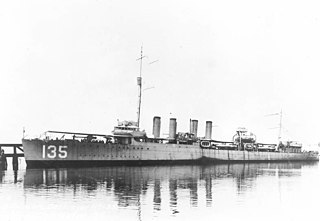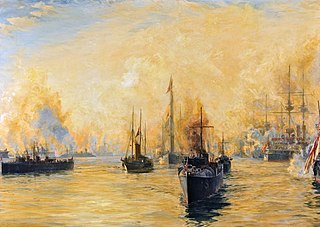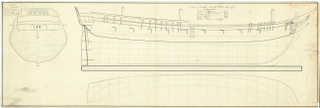Seven ships of the Royal Navy have been named HMS Prince of Wales, after numerous holders of the title the Prince of Wales.

Prince Albert Victor, Duke of Clarence and Avondale was the eldest child of the Prince and Princess of Wales. From the time of his birth, he was second in the line of succession to the British throne, but did not become king or Prince of Wales because he died before both his grandmother Queen Victoria and his father.
HMS Vanguard was a 74-gun third-rate ship of the line of the Royal Navy, launched on 6 March 1787 at Deptford. She was the sixth vessel to bear the name.

HMS Prince of Wales was a London-class pre-dreadnought battleship built for the Royal Navy in the first decade of the 20th century. She was one of two ships of the London- or Queen sub-class. Shortly after completion the ship was assigned to the Mediterranean Fleet and then to the Atlantic in 1909 and Home Fleets three year later. Prince of Wales often served as a flagship during her career.

The first USS Tillman (DD–135) was a Wickes-class destroyer in the United States Navy. She was named for Senator Benjamin Tillman. Transferred to the United Kingdom in World War II, she was commissioned in the Royal Navy as HMS Wells.

The first HMS Shah was a nineteenth-century unarmoured iron hulled, wooden sheathed frigate of Britain's Royal Navy designed by Sir Edward Reed. She was originally to be named HMS Blonde but was renamed following the visit of the Shah of Persia in 1873.

HMS Challenger was a Pearl-class corvette of the Royal Navy launched on 13 February 1858 at the Woolwich Dockyard. She served the flagship of the Australia Station between 1866 and 1870.
Canon John Neale Dalton was a Church of England clergyman and author. He was a chaplain to Queen Victoria, a Canon of Windsor, and tutor to the future King George V and his brother Prince Albert Victor.

HMY Alberta was a royal yacht of the Royal Navy of the United Kingdom. She was built by Pembroke Dock and launched in 1863.
HMS Prince Consort was the first ship to carry this name in the Royal Navy. Laid down as HMS Triumph, at HM Royal Dockyard, Pembroke as a 91-gun screw second-rate line-of-battle ship, she was renamed HMS Prince Consort on 14 February 1862 following the death of Prince Albert of Saxe-Coburg and Gotha, the husband of Queen Victoria.

HMS Alexandra was a central battery ironclad of the Victorian Royal Navy, whose seagoing career was from 1877 to 1900. She spent much of her career as a flagship, and took part in operations to deter the Russian Empire's aggression against the Ottoman Empire in 1878 and the bombardment of Alexandria in 1882. She was affectionately known by her crew as Old Alex.

HMS Inconstant was an unarmored, iron-hulled, screw frigate built for the Royal Navy in the late 1860s. Upon completion in 1869, she was the fastest warship in the world and was assigned to the Channel Squadron. Two years later the ship was transferred to the Detached Squadron for a brief time before she was paid off into reserve in 1872. Inconstant was recommissioned in 1880 for service with the Flying Squadron that circumnavigated the world in 1880–82. On the return voyage, the ship was diverted to Egypt during the Anglo-Egyptian War of 1882 and played a minor role supporting operations ashore. She was reduced to reserve again after her return and was served as an accommodation ship in 1897. Inconstant was hulked in 1904 and became a training ship in 1906. She continued in that role, under a variety of names, until she was sold for scrap in 1955 and subsequently broken up, the second-to-last surviving Pembroke-built warship in existence.

HMS Dauntless was a Danae-class light cruiser of the Royal Navy. She was built by Palmers Shipbuilding and Iron Company of Jarrow, launched on 10 April 1918 and commissioned on 22 November 1918.

HMS Blanche was a 32-gun Hermione-class fifth rate of the Royal Navy. She was ordered towards the end of the American War of Independence, but only briefly saw service before the outbreak of the French Revolutionary Wars in 1793. She enjoyed a number of successful cruises against privateers in the West Indies, before coming under the command of Captain Robert Faulknor. He took the Blanche into battle against a superior opponent and after a hard-fought battle, forced the surrender of the French frigate Pique. Faulknor was among those killed on the Blanche. She subsequently served in the Mediterranean, where she had the misfortune of forcing a large Spanish frigate to surrender, but was unable to secure the prize, which then escaped. Returning to British waters she was converted to a storeship and then a troopship, but did not serve for long before being wrecked off the Texel in 1799.

HMS Royal Albert was a 121 gun three-decker ship of the Royal Navy launched in 1854 at Woolwich Dockyard. She had originally been designed as a sailing ship but was converted to screw propulsion while still under construction.

HMS Comus was a corvette of the Royal Navy. She was the name ship of her class. Launched in April 1878, the vessel was built by Messrs. J. Elder & Co of Glasgow at a cost of £123,000.

HMS Wolverine was a Jason-class three-masted wooden screw corvette, of the Royal Navy. Later she became flagship of the Australia Station, eventually being presented to the Colony of New South Wales as a training ship for the New South Wales Naval Brigade and New South Wales Naval Artillery Volunteers.

HMS Tyne was a Royal Navy store ship. Charles Mitchell of Low Walker, Newcastle upon Tyne built her as yard number 354, and launched her on 19 January 1878 as the merchant ship Mariotis for the Moss Steam Ship Company of Liverpool. The Admiralty bought her for the Royal Navy on 8 March 1878. She was completed in June 1878.

The French gun-vessel Eclair was one of 20 chasse-marées built in 1785 in southern Brittany for use as service craft in harbour construction at Cherbourg. In 1793 Martin or Jacques Fabien converted ten of them into chaloupes-canonnières (gun-vessels). One of these received the name Eclair. Sir Richard Strachan's squadron captured her in 1795 in Cartaret Bay, and the Royal Navy took her into service as HMS Eclair. She then sailed to the West Indies where she was probably out of service by 1801. In 1802 she was hulked under the name HMS Safety. She then served as a prison ship at Jamaica around 1808 to 1810. She may have been sold at Tortola in 1817/18, but in 1841 or so was brought back into service there as a receiving hulk. She was broken up in 1879.

HMS Liffey was the name ship of five Liffey class of 51-gun wooden screw frigates of the Royal Navy. She was launched on 6 May 1856, at Devonport Dockyard, Plymouth.


















